How to Measure Customer Service Performance Using Latest Trends
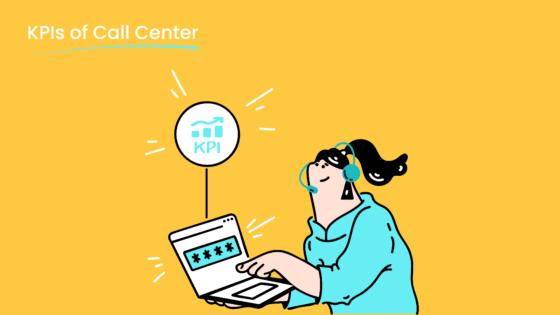
Companies today operate in a digital world where knowing how to measure customer service performance is crucial for business success. High-quality service boosts customer satisfaction and loyalty. Research shows that companies with strong omnichannel strategies retain 89% of their customers, while weak strategies retain only 33% (source). Customers who enjoy great experiences from a service team are 3.6 times more likely to buy again. Sobot leads this transformation with Sobot AI and the Sobot call center, helping businesses deliver seamless experiences and measurable satisfaction across every customer interaction.
Customer Service Metrics Overview

What Are Customer Service Metrics
Customer service metrics are key performance indicators that help organizations measure the quality and effectiveness of their customer service operations. These metrics track how well a company meets customer needs and expectations during every interaction. Businesses use customer experience metrics to understand satisfaction, engagement, and loyalty.
Some of the most commonly used customer service metrics across industries include:
- Customer Satisfaction Score (CSAT): Measures satisfaction after a service interaction, often using a quick survey.
- Net Promoter Score (NPS): Gauges how likely customers are to recommend the company, reflecting loyalty and engagement.
- First Response Time (FRT): Tracks how quickly agents reply to customer inquiries, impacting the overall experience.
- Average Resolution Time: Shows how long it takes to resolve customer issues, indicating service efficiency.
- First Contact Resolution Rate (FCR): Measures the percentage of issues solved in the first interaction, showing service effectiveness.
- Customer Effort Score (CES): Assesses how easy it is for customers to get help or solve problems.
- Customer Churn Rate: Indicates how many customers stop using the service, highlighting satisfaction and retention challenges.
| Metric Name | Definition | Purpose / What it's good for |
|---|---|---|
| Customer Satisfaction Score (CSAT) | Measures customer satisfaction as a percentage, often after specific interactions. | Understands customer happiness and satisfaction at a point in time. |
| Net Promoter Score (NPS) | Measures customers' willingness to promote the business. | Gauges customer loyalty and advocacy. |
| Customer Effort Score (CES) | Measures how difficult it is for customers to do business with the company. | Identifies friction in customer interactions. |
| Customer Retention Rate (CRR) | Measures the rate at which customers are retained over time. | Tracks customer loyalty and business health. |
| Customer Churn Rate | Measures the rate at which customers leave the business. | Helps identify customer loss and areas for improvement. |
| Time to Resolution (TTR) | Measures how long it takes to resolve a customer support ticket. | Evaluates support team efficiency. |
| First Response Time (FRT) | Measures how quickly support agents respond to tickets. | Indicates responsiveness of support. |
| First Contact Resolution (FCR) | Measures the proportion of tickets resolved on first contact. | Reflects effectiveness of support interactions. |
Digital-first companies often use advanced customer experience metrics, such as sentiment analysis and AI-driven engagement rates, to gain deeper insights into the customer journey. Sobot’s omnichannel solutions help businesses track these metrics across all channels, ensuring a unified view of the customer experience.
Why Metrics Matter
Customer service metrics play a vital role in business success. They provide detailed insights into customer needs and highlight trends that drive improvement. By tracking customer experience metrics, companies can measure the effectiveness of their service programs and understand the return on investment.
Metrics help balance revenue and expenses by showing the true value of customer service within the organization. They also support recognizing individual agent performance and identifying training or automation opportunities. For example, Sobot’s unified workspace and analytics tools allow managers to monitor key performance indicators in real time, motivating teams and aligning their efforts with company goals.
Continuous monitoring of customer service metrics leads to higher satisfaction, better retention, and increased revenue. Companies that use these metrics can quickly spot areas for improvement and adapt their strategies. This approach builds stronger engagement and loyalty, making the customer experience more consistent and rewarding.
Tip: Companies that regularly review their customer service metrics see higher satisfaction scores and lower churn rates, which directly impact long-term business growth.
Traditional Customer Service Metrics
CSAT
The customer satisfaction score (CSAT) stands as one of the most widely recognized customer service metrics. Companies use CSAT to measure satisfaction immediately after a service interaction. This metric captures the customer's reaction in real time, usually through a simple survey asking for a rating from 1 to 5. Businesses calculate CSAT by taking the percentage of customers who select the top two ratings. This approach gives a clear view of short-term satisfaction and helps predict customer retention. Many organizations now combine CSAT with other metrics, such as average first response time and average resolution time, to create a more complete picture of service quality. This composite method makes CSAT even more effective for tracking customer experience and guiding improvements.
NPS
The net promoter score (NPS) measures customer loyalty and their willingness to recommend a brand. Companies ask customers how likely they are to recommend the service on a scale from 0 to 10. NPS divides customers into promoters, passives, and detractors. High NPS scores signal strong satisfaction and loyalty. Industry benchmarks help companies compare their scores and set realistic goals. For example, top consumer brands like Apple and Tesla often achieve NPS scores above 70, while retail and technology sectors average between 40 and 60.
| Industry / Brand | Typical NPS Range |
|---|---|
| Retail | 50 - 61 |
| Financial Services | 71 |
| Technology / SaaS | 41 |
| Apple | 60 - 75 |
| Tesla | 70 - 80 |
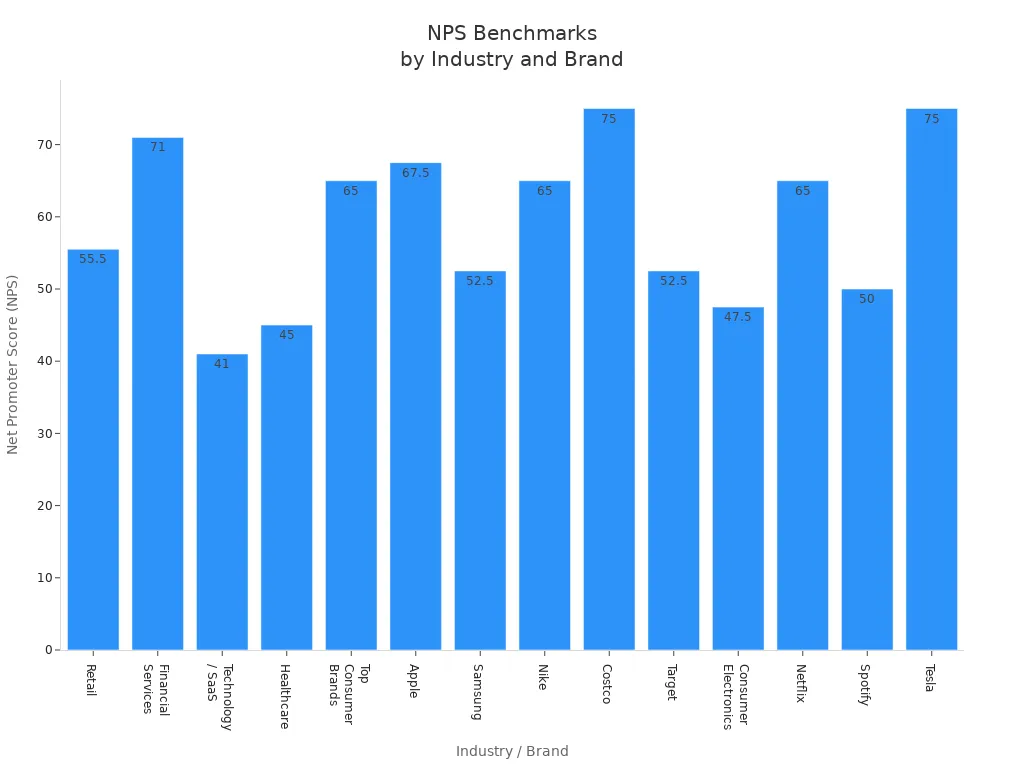
First Response Time
First response time (FRT) tracks how quickly a service team replies to a customer inquiry. Fast responses build trust and show customers that their needs matter. Leading customer service organizations achieve different FRT benchmarks depending on the channel. For example, live chat responses often take less than a minute, while email responses average around 12 hours. Smaller companies tend to respond faster than larger enterprises. Sobot’s unified workspace helps teams monitor FRT across all channels, making it easier to meet customer expectations.
| Channel | Good Performance |
|---|---|
| 12 hours or less | |
| Social Media | 5 hours or less |
| Live Chat | 1 minute or less |
| Phone | 80% within 20 seconds |
Resolution Time
Resolution time measures how long it takes to solve a customer issue. Quick resolution leads to higher satisfaction and loyalty. Research shows that 90% of customers expect a fast response, and 77% value brands that respect their time. Companies that reduce resolution time see higher customer satisfaction scores and lower churn. For example, Hoag Health improved its customer satisfaction by 13% after reducing resolution time by 86%. Sobot’s analytics tools help businesses track and improve resolution time, ensuring customers feel valued.
First Contact Resolution
First contact resolution (FCR) is a key customer service metric that shows the percentage of issues solved during the first interaction. High FCR rates mean customers do not need to contact support multiple times for the same problem. Top-performing companies in contact centers achieve FCR rates as high as 91%. In retail, high performers reach 88%. Achieving high FCR boosts satisfaction, reduces operational costs, and increases loyalty. Sobot’s omnichannel solution supports high FCR by giving agents access to all customer data and previous interactions in one place.
| Industry Sector | High-Performing FCR (%) |
|---|---|
| Contact Centers | 91 |
| Retail | 88 |
| Insurance | 84 |
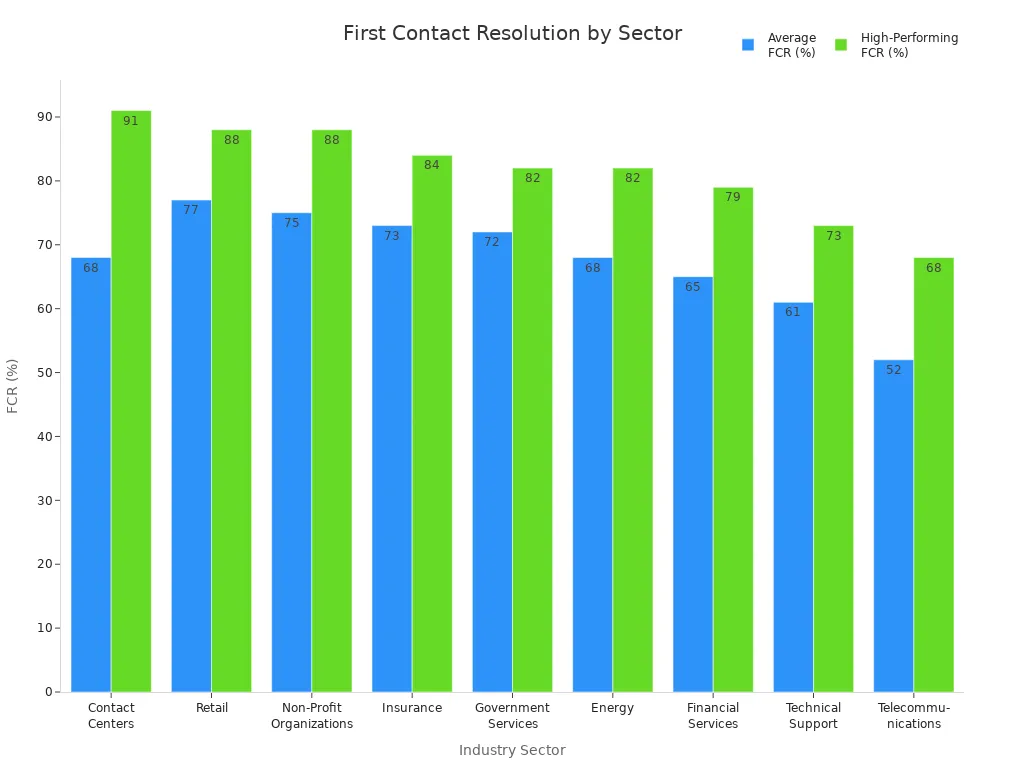
Note: Tracking these customer service metrics helps companies deliver better service, improve satisfaction, and build lasting customer relationships.
Latest Customer Experience Metrics
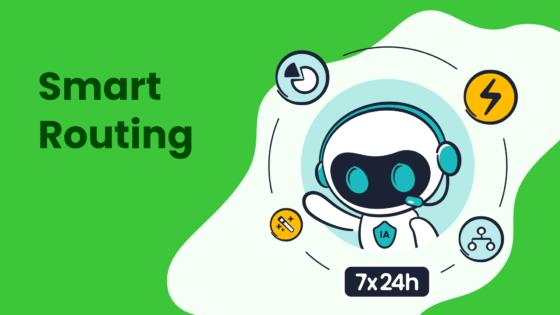
Customer Effort Score
Customer experience metrics have evolved to focus on how easy it is for customers to get help and solve problems. The customer effort score (CES) stands out as a leading metric in this area. Companies use CES to measure how much effort a customer must exert during a service interaction. After a support call or chat, businesses often ask, “How easy was it to resolve your issue today?” Customers respond on a scale, usually from “very easy” to “very difficult.”
Research from Gartner and Harvard Business Review shows that CES is a strong predictor of customer loyalty. When customers report low effort, 94% say they would likely purchase again. Only 9% of customers who have low-effort experiences become disloyal, while 96% of those who face high effort turn away from the brand. High effort also leads to negative word-of-mouth and lost future purchases. Companies that reduce effort see higher retention, more repeat business, and better referrals.
Sobot’s omnichannel solution helps businesses lower customer effort by unifying all service channels into one workspace. Agents can access customer history, previous tickets, and preferences instantly. This reduces the time and steps needed for resolution, making every experience smoother and more efficient.
Companies that focus on reducing customer effort see a direct impact on loyalty, retention, and positive feedback.
Sentiment Analysis
Modern customer experience metrics now include advanced sentiment analysis. This process uses AI to understand the emotions behind customer messages, reviews, and conversations. Sentiment analysis goes beyond simple positive or negative ratings. It detects emotions like joy, anger, or frustration, and even identifies specific issues within a conversation.
AI-powered sentiment analysis tools, such as IBM Watson NLU, can process unstructured text from emails, chats, and social media. These tools help companies spot dissatisfaction early and act before problems escalate. For example, companies like James Villas reduced resolution times by 51% and improved satisfaction scores by using sentiment analysis. Starbucks adapts its product offerings based on customer sentiment trends, showing the power of these insights.
Sobot’s AI-driven analytics include customer sentiment analysis across all channels. By monitoring real-time conversations, Sobot helps businesses identify unhappy customers and resolve issues quickly. This proactive approach improves service quality, increases loyalty, and reduces churn.
- AI-powered sentiment analysis acts as an early-warning system by analyzing multiple customer touchpoints.
- Churn prediction improves by identifying negative sentiment spikes and declining engagement.
- Voice of Customer strategies become more effective by consolidating feedback into actionable insights.
- Continuous updates to AI models ensure accurate and reliable sentiment detection.
Omnichannel Metrics with Sobot
Omnichannel customer experience metrics provide a complete view of every customer journey. Unlike single-channel metrics, which only show part of the picture, omnichannel metrics unify data from all touchpoints—phone, chat, email, social media, and more. This unified approach helps companies understand the full customer lifecycle and personalize every interaction.
Key omnichannel metrics include:
- Customer Lifetime Value (LTV): Measures the total value a customer brings across all channels.
- Recency and Repurchase Rates: Tracks when customers last purchased and how often they return.
- Customer Satisfaction (NPS, CSAT): Combines survey data from every channel for a holistic view.
- Ticket Volume: Aggregates service issues from all channels to spot friction points.
Sobot’s Omnichannel Solution integrates these metrics into a single dashboard. Agents see every interaction, regardless of channel, in one place. This reduces confusion, speeds up resolution, and ensures a consistent experience. Businesses using Sobot report up to 30% higher productivity and improved customer satisfaction. By tracking omnichannel metrics, companies can identify trends, optimize engagement, and drive higher retention.
Omnichannel metrics help businesses increase retention rates up to 89% and boost customer lifetime value by 30% (source).
Retention and Churn
Retention and churn are critical customer experience metrics that reveal the health of a business. Retention measures how many customers stay over time, while churn shows how many leave. High retention signals strong loyalty and satisfaction. High churn often points to unresolved issues or poor service.
The most effective metrics for tracking retention and churn include:
- Revenue Churn Rate: Shows the financial impact of lost customers.
- Customer Lifetime Value (CLTV): Predicts total revenue from a customer, guiding loyalty strategies.
- Customer Acquisition Cost (CAC): Compares the cost to gain new customers with the value they bring.
- Net Promoter Score (NPS): Measures loyalty and likelihood to recommend.
- Engagement Metrics: Tracks how often customers use the service.
- Customer Support Tickets: High ticket volume or unresolved issues can signal risk of churn.
Sobot’s unified workspace and analytics tools make it easy to monitor these metrics. Businesses can track customer churn rate, repeat purchase ratios, and engagement levels in real time. By identifying at-risk customers early, companies can take action to improve retention and reduce churn.
Companies that monitor retention and churn metrics closely can adjust their service strategies to keep customers happy and loyal.
AI-Driven Analytics
AI-driven analytics have transformed customer experience metrics by making them more accurate and actionable. AI tools analyze massive amounts of data in real time, spotting trends and predicting customer needs before issues arise. This leads to faster resolution, better service, and higher satisfaction.
Key benefits of AI-driven analytics include:
- Real-time, predictive insights enable proactive service and reduce response times by 20%.
- Advanced pattern recognition improves trend spotting accuracy by 35%.
- Hyper-personalization increases engagement by 30% and reduces customer effort by 40%.
- Sentiment analysis improves satisfaction scores by 15% and reduces churn by 20%.
- AI optimizes workforce management, reducing labor costs by up to 30% and improving service delivery.
Sobot’s AI-powered Voice/Call Center and Omnichannel Solution deliver these benefits. The platform uses AI to route calls, analyze conversations, and provide agents with next-best actions. Automated alerts notify teams when key metrics change, allowing immediate action. Personalized recommendations guide agents to resolve issues faster, improving the overall customer experience.
AI-driven analytics help businesses anticipate customer needs, reduce churn, and optimize every service interaction.
In summary, the latest customer experience metrics—customer effort score, sentiment analysis, omnichannel metrics, retention and churn, and AI-driven analytics—give companies a deeper understanding of every customer journey. Sobot’s intelligent solutions empower businesses to track, analyze, and act on these metrics, driving loyalty, satisfaction, and long-term growth.
How to Measure Customer Service Performance
Aligning Metrics with Goals
Organizations that want to know how to measure customer service performance must first connect their customer experience metrics to clear business goals. This alignment ensures that every effort in service directly supports the company’s mission and vision. Companies often start by clarifying their long-term objectives, such as increasing customer retention, improving satisfaction, or reducing operational costs.
A structured approach helps teams break down these goals into measurable steps. The following process outlines how businesses can align metrics with their strategic direction:
-
Clarify Strategic Goals
Leaders define what the company wants to achieve, such as higher customer loyalty or faster response times. -
Define KPI Goals
Each strategic goal gets a set of key performance indicators (KPIs) that measure progress. For example, if the goal is to improve loyalty, NPS and retention rates become important KPIs. -
Set Measurable Targets
Teams establish clear benchmarks for each KPI. These targets provide accountability and help track customer experience metrics over time. -
Cascade Goals to Teams
Departments and teams receive specific targets that support the overall strategy. This ensures everyone works toward the same objectives. -
Review and Adjust Regularly
Companies revisit their KPIs to keep them relevant as business needs change. Regular reviews help maintain alignment and drive continuous improvement. -
Tie Compensation to KPIs
Linking rewards to performance motivates employees to focus on the right metrics.
Note: Experts recommend focusing on a small set of 3-5 aligned metrics. This keeps the process clear and actionable, avoiding data overload.
Organizations also benefit from distinguishing between output and outcome metrics. Output metrics, like the number of tickets solved, show activity. Outcome metrics, such as customer satisfaction or retention, reveal the impact of those activities. By tracking both, companies get a full picture of service performance.
Selecting the Right Metrics
Choosing the right customer experience metrics is essential for accurate measurement and improvement. Not every metric fits every business model. Companies must select metrics that reflect their unique customer interactions and service goals.
A balanced approach combines operational efficiency with customer experience quality. The following criteria help organizations select the most relevant metrics:
-
Align with Business Goals
Metrics should support the company’s specific objectives, such as reducing churn or increasing satisfaction. -
Use a Balanced Scorecard
Combine metrics that measure both efficiency (like resolution time) and experience (like CSAT or NPS). -
Consider Customer Interaction Types
Retailers may focus on first contact resolution, while financial services might prioritize compliance and security. -
Benchmark Against Industry Standards
Comparing performance to industry averages helps companies stay competitive. For example, top-performing contact centers achieve first contact resolution rates above 90% (source). -
Select Actionable Metrics
Choose metrics that lead to clear actions. For instance, tracking ticket reopens can highlight training needs for agents. -
Focus on Measurable Results
Metrics like customer satisfaction, agent performance, and cost per contact provide direct insights into business outcomes.
| Metric Type | Example Metrics | Purpose |
|---|---|---|
| Efficiency | First Response Time, TTR | Improve speed and productivity |
| Experience Quality | CSAT, NPS, CES | Enhance satisfaction and loyalty |
| Financial Impact | Cost per Contact, Churn | Control costs and retention |
Tip: Companies that regularly track customer experience metrics see higher satisfaction and lower churn, which drives long-term growth.
Implementing with Sobot
After selecting the right metrics, organizations need effective tools to track customer experience metrics and measure customer experience across all channels. Sobot provides a unified workspace and advanced analytics that make this process seamless.
Here is a step-by-step guide for implementing and tracking customer service performance with Sobot:
-
Integrate Sobot with Existing Systems
Sobot connects with CRM platforms, e-commerce tools, and other business systems. This integration ensures all customer data and interactions flow into one platform. -
Customize Chatbot Flows and Workspaces
Companies use Sobot to build tailored chatbot flows that match their service needs. The unified workspace allows agents to manage calls, chats, and tickets from every channel. -
Set Clear Goals and Benchmarks
Teams define specific targets for each metric, such as reducing average resolution time by 20% or increasing CSAT to 95%. -
Monitor Real-Time Performance
Sobot’s analytics dashboard displays live data on key metrics. Managers can see engagement rates, resolution times, and customer sentiment at a glance. -
Analyze and Adjust Strategies
Regular analysis helps teams spot trends and areas for improvement. For example, if sentiment analysis shows rising frustration, managers can adjust training or workflows. -
Automate Reporting and Alerts
Sobot automates metric tracking and sends alerts when performance drops below targets. This proactive approach helps teams respond quickly to issues. -
Optimize with AI Insights
Sobot’s AI-driven analytics recommend next-best actions for agents. The system identifies patterns, predicts customer needs, and suggests ways to improve service.
Sobot’s platform supports over 6 million online communications and 3 million phone calls daily, with a system uptime of 99.99%. This reliability ensures businesses can measure customer experience and track customer experience metrics without interruption.
Example:
A retail company using Sobot’s omnichannel solution noticed a spike in ticket volume after launching a new product. By tracking metrics like first response time and customer effort score, the team identified a common issue with product setup. Sobot’s analytics helped them update chatbot scripts and agent training, reducing resolution time by 30% and boosting customer satisfaction.
Key Benefits of Using Sobot:
- Unified workspace for all service channels
- Real-time analytics and customizable dashboards
- AI-powered insights for proactive service
- Seamless integration with existing business systems
- Automated alerts and reporting for continuous improvement
Companies that use Sobot to measure customer service performance report higher agent productivity, improved customer satisfaction, and lower operational costs.
In summary, knowing how to measure customer service performance requires aligning metrics with business goals, selecting the right customer experience metrics, and using advanced tools like Sobot for tracking and analysis. This approach empowers organizations to deliver exceptional service, drive loyalty, and achieve measurable business results.
Best Practices for Metrics and Retention
Tracking and Analyzing Data
Successful organizations track and analyze customer service data to drive continuous improvement. They start by defining clear objectives, such as increasing retention or improving customer loyalty. Teams collect feedback from multiple channels, including surveys, social media, and direct conversations. Integrating these data sources gives a unified view of the customer experience.
Best practices include:
- Use actionable metrics like Customer Effort Score to identify areas for improvement.
- Balance leading indicators, such as First Response Time, with lagging indicators like customer churn.
- Foster open communication by allowing frontline staff to share feedback in real time.
- Apply structured improvement methods, such as PDCA or Kaizen, to address service issues.
- Tailor communication of results to stakeholders using dashboards and visuals.
- Combine AI tools with human empathy to enhance efficiency and satisfaction.
- Invest in CX software, such as Sobot’s unified workspace, to automate data collection and analysis.
Sobot’s analytics dashboard helps teams monitor key metrics, spot trends, and make data-driven decisions. This approach supports higher customer engagement and loyalty.
Improving Retention with Metrics
Customer service metrics play a vital role in boosting retention. Companies use metrics like Customer Retention Rate, Customer Churn Rate, Net Promoter Score, Customer Effort Score, and Customer Satisfaction Score to identify gaps and tailor experiences. Omnichannel support, powered by platforms like Sobot, enables personalized interactions and faster resolutions across every channel.
Quick responses to customer inquiries increase satisfaction and loyalty. Agents equipped with customer history and context can personalize support, reducing frustration and improving engagement. Many organizations also use loyalty programs and referral incentives to reward repeat business and advocacy, which increases customer lifetime value.
A positive employee experience leads to stronger customer relationships. When staff feel valued, they deliver better service, which supports long-term retention and loyalty. Sobot’s tools help companies track these metrics and implement effective customer engagement strategies.
Avoiding Common Pitfalls
Many organizations face pitfalls when tracking customer service metrics. Choosing the wrong KPIs can mislead efforts, so teams must align metrics with business goals. Over-reliance on a single metric, such as NPS, gives an incomplete picture. A balanced set of metrics linked to outcomes provides a clearer view of customer experience.
Ignoring qualitative feedback means missing the reasons behind scores. Teams should include open-ended comments and sentiment analysis. Employee experience also matters; measuring engagement helps improve both service and retention.
Disconnected tools fragment data and insights. Integrated platforms like Sobot unify customer data, align metrics with strategy, and support a holistic view of the customer journey. Regularly reviewing and acting on insights ensures that metrics drive meaningful change and support customer loyalty.
Tip: Surveying too often can cause fatigue. Strategic timing keeps feedback fresh and valuable.
Real-World Effectiveness: Sobot Case Study
Weee! Success Story

Weee!, a leading online Asian supermarket in America, faced challenges with its customer service operations. The company needed to improve satisfaction, speed up resolution, and handle a growing number of customer requests. Weee! chose Sobot’s Voice/Call Center solution to address these needs. Sobot provided a flexible IVR system, seamless integration with Weee!’s CRM, and a unified workspace for agents. This allowed agents to access customer history and manage every service interaction efficiently.
After implementing Sobot, Weee! saw major improvements in customer satisfaction and service quality. The system’s 99.99% uptime ensured that customers always received support when needed. Sobot’s AI-powered features helped agents resolve issues faster and deliver a consistent experience across all channels.
Key Results and Takeaways
Weee! achieved measurable gains in several key areas after adopting Sobot’s solution. The table below highlights the improvements:
| Improvement Metric | Measurable Result |
|---|---|
| Reception Efficiency Increase | 48% |
| Average Handle Time Reduction | 41% |
| First-Contact Resolution Rate | 54% |
| Net Promoter Score (NPS) | Increased |
| System Uptime | 99.99% |
| Integration with CRM & Tech Systems | Seamless and exceeds expectations |
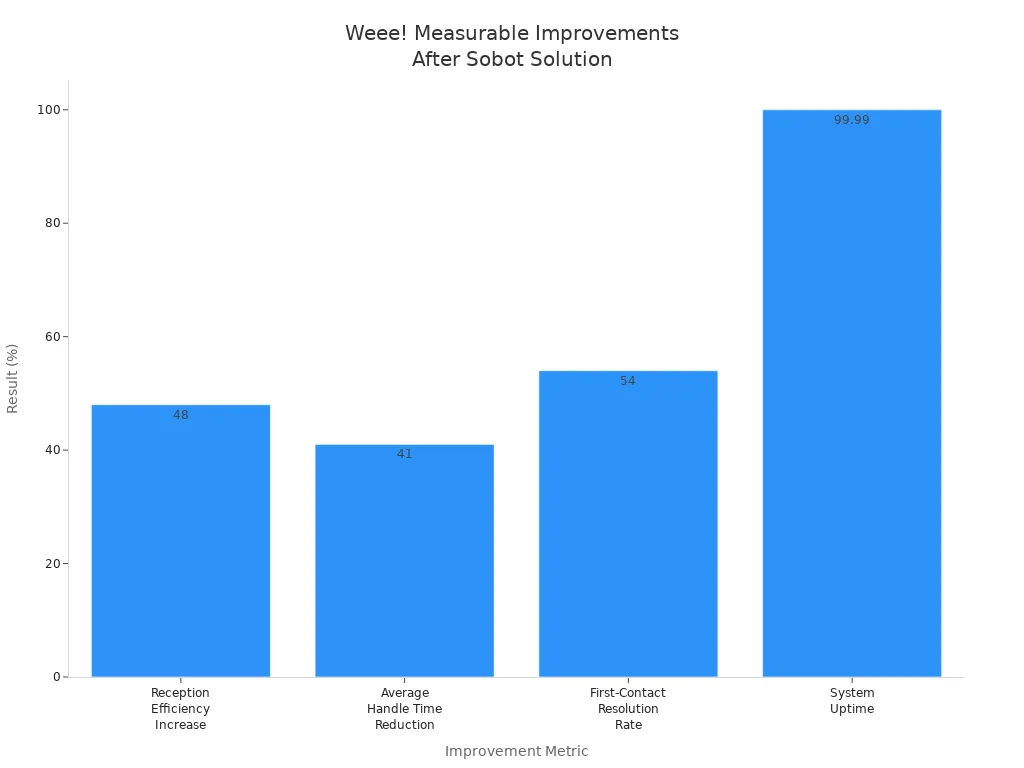
Customer satisfaction reached new highs as agents resolved more issues on the first contact. The reduction in average handle time meant customers spent less time waiting for help. Seamless integration with existing systems made the transition smooth for both staff and customers. Positive feedback from customers confirmed the value of these changes. Sobot’s solution empowered Weee! to deliver reliable, high-quality service and build lasting customer loyalty.
Sobot’s Voice/Call Center solution demonstrates how advanced technology can transform customer service, boost satisfaction, and drive measurable business results.
Companies that excel in customer service focus on speed, convenience, and knowledgeable help. The table below highlights the most effective customer service metrics and trends:
| Metric / Trend | Key Insight |
|---|---|
| Customer Satisfaction | 87% of companies track this metric |
| Net Promoter Score | Drives loyalty and repeat customer purchases |
| Customer Effort Score | Predicts customer retention |
| Predictive Analytics | 67% seek advanced analytics for improvement |
A data-driven approach helps organizations understand customer behavior, optimize retention, and drive growth. Sobot’s unified platform enables real-time tracking, AI-powered insights, and seamless integration, supporting superior customer experiences. Companies should define key customer metrics, invest in agent training, and leverage advanced tools like Sobot to enhance customer satisfaction and retention.
FAQ
What are the most important customer service metrics to track?
Companies often track customer satisfaction score, net promoter score, first response time, and resolution time. These metrics help measure how well a business meets customer needs. Sobot’s analytics dashboard provides real-time tracking for these key metrics, supporting better decision-making and improved customer experience.
How does Sobot help improve customer retention?
Sobot’s omnichannel solution unifies all customer interactions in one workspace. Agents access complete customer histories, which helps resolve issues faster. Businesses using Sobot report up to 30% higher productivity and increased customer retention rates. This unified approach leads to more satisfied and loyal customers.
Why is customer effort score important?
Customer effort score measures how easy it is for a customer to get help. Studies show that 94% of customers who experience low effort will likely buy again. Sobot’s AI-powered tools help reduce effort by streamlining communication and automating routine tasks, making every customer interaction smoother.
Can Sobot integrate with existing business systems?
Yes. Sobot integrates with CRM platforms, e-commerce tools, and other business systems. This integration ensures that customer data flows seamlessly, allowing agents to deliver personalized service. Companies benefit from a unified view of each customer, which improves satisfaction and operational efficiency.
How can companies use analytics to reduce customer churn?
Analytics identify patterns in customer behavior and highlight at-risk customers. Sobot’s platform uses AI to monitor sentiment and engagement. When the system detects negative trends, teams can act quickly to address issues. This proactive approach helps companies reduce customer churn and increase long-term loyalty.
See Also
Enhancing Call Center Efficiency Through Effective Monitoring Techniques
Essential Best Practices For Managing Call Center Quality
The Best Customer Service Software Solutions For 2024
